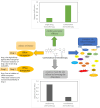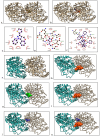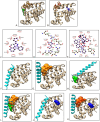Pyrazoline B-Paclitaxel or Doxorubicin Combination Drugs Show Synergistic Activity Against Cancer Cells: In silico Study
- PMID: 38435441
- PMCID: PMC10908341
- DOI: 10.2147/AABC.S452281
Pyrazoline B-Paclitaxel or Doxorubicin Combination Drugs Show Synergistic Activity Against Cancer Cells: In silico Study
Abstract
Background: Multidrug resistance in various cancer types is a major obstacle in cancer treatment. The concept of a single drug molecular target often causes treatment failure due to the complexity of the cellular processes. Therefore, combination chemotherapy, in which two or more anticancer drugs are co-administered, can overcome this problem because it potentially have synergistic efficacy besides reducing resistance, and drug doses. Previously, we reported that pyrazoline B had promising anticancer activity in both in silico and in vitro studies. To increase the efficacy of this drug, co-administration with established anticancer drugs such as doxorubicin and paclitaxel is necessary.
Materials and methods: In this study, we used an in silico approach to predict the synergistic effect of pyrazoline B with paclitaxel or doxorubicin using various computational frameworks and compared the results with those of an established study on the combination of doxorubicin-cyclophosphamide and paclitaxel-ascorbic acid.
Results and discussion: Drug interaction analysis showed the combination was safe with no contraindications or side effects. Furthermore, molecular docking studies revealed that doxorubicin-pyrazoline B and doxorubicin-cyclophosphamide may synergistically inhibit cancer cell proliferation by inhibiting the binding of topoisomerase I to the DNA chain. Moreover, the combination of pyrazoline B-paclitaxel may has synergistic activity to cause apoptosis by inhibiting Bcl2 binding to the Bax fragment or inhibiting cell division by inhibiting α-β tubulin disintegration. Paclitaxel-ascorbic acid had a synergistic effect on the inhibition of α-β tubulin disintegration.
Conclusion: The results show that this combination is promising for further in vitro and in vivo studies.
Keywords: doxorubicin; in silico study; paclitaxel; pyrazoline B; synergistic effect.
© 2024 Wiraswati et al.
Conflict of interest statement
The authors report no conflicts of interest in this work.
Figures





Similar articles
-
Prediction of Drug Synergism between Peptides and Antineoplastic Drugs Paclitaxel, 5-Fluorouracil, and Doxorubicin Using In Silico Approaches.Int J Mol Sci. 2022 Dec 21;24(1):69. doi: 10.3390/ijms24010069. Int J Mol Sci. 2022. PMID: 36613510 Free PMC article.
-
Reversal of multidrug resistance by two nordihydroguaiaretic acid derivatives, M4N and maltose-M3N, and their use in combination with doxorubicin or paclitaxel.Cancer Chemother Pharmacol. 2006 Nov;58(5):640-53. doi: 10.1007/s00280-006-0214-9. Epub 2006 Mar 17. Cancer Chemother Pharmacol. 2006. PMID: 16544145
-
Ratiometric co-encapsulation and co-delivery of doxorubicin and paclitaxel by tumor-targeted lipodisks for combination therapy of breast cancer.Int J Pharm. 2019 Apr 5;560:191-204. doi: 10.1016/j.ijpharm.2019.02.009. Epub 2019 Feb 12. Int J Pharm. 2019. PMID: 30769131
-
Current status of paclitaxel in the treatment of breast cancer.Breast Cancer Res Treat. 1995;33(1):27-37. doi: 10.1007/BF00666068. Breast Cancer Res Treat. 1995. PMID: 7749130 Review.
-
Paclitaxel combination therapy in the treatment of metastatic breast cancer: a review.Semin Oncol. 1996 Oct;23(5 Suppl 11):46-56. Semin Oncol. 1996. PMID: 8893900 Review.
References
-
- Kars MD, Iseri OD, Gündüz U, Ural AU, Arpaci F, Molnár J. Development of rational in vitro models for drug resistance in breast cancer and modulation of MDR by selected compounds. Anticancer Res. 2006;26(6b):4559. - PubMed
LinkOut - more resources
Full Text Sources
Research Materials

